The Characteristics of Lithofacies and Depositional Model of Fine-Grained Sedimentary Rocks in the Ordos Basin, China
Abstract
1. Introduction
2. Geological Settings
3. Materials and Methods
3.1. Characteristics of Outcrop Profiles
3.2. Methodology
3.2.1. Analytical Methods
3.2.2. Data Presentation
4. Results
4.1. Characteristics of Organic Matter
4.2. Lithofacies Classification
4.2.1. Quasi-Laminated Clayey Shale Facies (CM)
4.2.2. Blocky Silty Mudstone Facies (CM-1)
4.2.3. Quasi-Laminated Silty Shale Facies (CM-1)
4.2.4. Laminated Silty Shale Facies (CM-1)
4.2.5. Blocky Mixed Mudstone Facies (M)
4.2.6. Laminated Argillaceous Siltstone Facies (S-2)
4.3. Elemental Geochemical Characteristics
4.3.1. Bulk Oxide
4.3.2. Trace Elements
5. Discussion
5.1. Main Control Factors of Fine-Grained Sediment Lithofacies
5.1.1. Paleoclimate
5.1.2. Redox Conditions
5.1.3. Paleoproductivity
5.1.4. Terrigenous Influx
5.2. Lithofacies Assemblages and Sedimentary Models of Fine-Grained Sediments
6. Conclusions
- (1)
- In view of the mineral composition content, TOC, structure, texture, and lamination morphology of mudstone/shale, the fine-grained sediments of the Chang 7 Mb. are divided into six lithofacies: quasi-laminated clayey shale, blocky silty mudstone, quasi-laminated silty shale, laminated silty shale, blocky mixed mudstone, and laminated argillaceous siltstone lithofacies.
- (2)
- Changes in the depositional environment control the petrographic changes in the Ordos Basin. Paleoclimate and terrestrial input have a strong influence on the upper part of the Chang 7 Mb., and paleoproductivity has a greater effect on the lower part of the Chang 7 Mb., while redox conditions play a key role in the preservation of fine-grained sediments. The warm, humid, and anoxic bottom water environment, higher primary productivity, and low terrestrial input are more likely to produce clayey facies, while massive mixed facies and siltstone facies are likely to appear in the upper part of the Chang 7 Mb.
- (3)
- Two lithofacies assemblages are identified in the Chang 7 Member. The assemblage composed of clayey shale, laminated silty shale, quasi-laminated silty shale, and laminated argillaceous siltstone lithofacies mainly occurs in the deep-water sedimentary environment of the semi-deep–deep lake facies in the lower Chang 7 Member. Moreover, the assemblage of the mixed mudstone and blocky silty mudstone lithofacies is deposited in the shallow-water sedimentary environment or delta facies at the margin of the lake basin.
Author Contributions
Funding
Data Availability Statement
Conflicts of Interest
References
- Zou, C.; Pan, S.; Horsfield, B.; Yang, Z.; Hao, S.; Liu, E.; Zhang, L. Oil retention and intrasource migration in the organic-rich lacustrine Chang 7 shale of the Upper Triassic Yanchang Formation, Ordos Basin, central China. AAPG Bull. 2019, 103, 2627–2663. [Google Scholar] [CrossRef]
- Liu, M.; Xiong, C. Diagenesis and reservoir quality of deep-lacustrine sandy-debris-flow tight sandstones in Upper Triassic Yanchang Formation, Ordos Basin, China: Implications for reservoir heterogeneity and hydrocarbon accumulation. J. Pet. Sci. Eng. 2021, 202, 108548. [Google Scholar] [CrossRef]
- Li, Z.; Wu, S.; Xia, D.; Zhang, X.; Huang, M. Diagenetic alterations and reservoir heterogeneity within the depositional facies: A case study from distributary-channel belt sandstone of Upper Triassic Yanchang Formation reservoirs (Ordos Basin, China). Mar. Pet. Geol. 2017, 86, 950–971. [Google Scholar] [CrossRef]
- Xue, C.; Wu, J.; Qiu, L.; Zhong, J.; Zhang, S.; Zhang, B.; Wu, X.; Hao, B. Lithofacies classification and its controls on the pore structure distribution in Permian transitional shale in the northeastern Ordos Basin, China. J. Pet. Sci. Eng. 2020, 195, 107657. [Google Scholar] [CrossRef]
- Kane, O.I.; Hu, M.; Cai, Q.; Deng, Q.; Yang, W.; Zuo, M. Sedimentary facies, lithofacies paleogeography, and an evaluation of the Ordovician sequences in the Sichuan Basin, southwest China. Mar. Pet. Geol. 2023, 149, 106096. [Google Scholar] [CrossRef]
- Wang, E.; Guo, T.; Li, M.; Li, C.; Dong, X.; Zhang, N.; Feng, Y. Exploration potential of different lithofacies of deep marine shale gas systems: Insight into organic matter accumulation and pore formation mechanisms. J. Nat. Gas Sci. Eng. 2022, 102, 104563. [Google Scholar] [CrossRef]
- Gao, Y.; Wen, Z.; Xu, Y.; Song, H.; Li, W.; Yu, Y.; Ke, C. Geochemical characteristics of the Chang7 organic-rich fine-grained sedimentary rocks and its relationship with the tight oil in Longdong area, Northwest China. J. Pet. Explor. Prod. Technol. 2020, 10, 1803–1816. [Google Scholar] [CrossRef]
- Mahran, T.; Hassan, A.M. Controls on Late Miocene to Early Quaternary continental sedimentation during the development of the Sohag basin, Nile Valley, Egypt. J. Afr. Earth Sci. 2023, 199, 104829. [Google Scholar] [CrossRef]
- Loucks, R.G.; Ruppel, S.C. Mississippian Barnett Shale: Lithofacies and depositional setting of a Deep-Water Shale-Gas Succession in the Fort Worth Basin, Texas. AAPG Bull. 2007, 91, 579–601. [Google Scholar] [CrossRef]
- Hickey, J.J.; Henk, B. Lithofacies Summary of the Mississippian Barnett Shale, Mitchell 2 T.P. Sims Well, Wise County, Texas. AAPG Bull. 2007, 91, 437–443. [Google Scholar] [CrossRef]
- Fu, J.; Deng, X.; Zhang, X.; Luo, A.; Nan, Q. Relationship between deepwater sandstone and tight oil of the Triassic Yanchang Formation in Ordos Basin. J. Palaeogeogr. 2013, 15, 624–634. [Google Scholar]
- Zhou, Z.; Wang, G.; Ran, Y.; Lai, J.; Cui, Y.; Zhao, X. A Logging Identification Method of Tight Oil Reservoir Lithology and Lithofacies: A Case from Chang7 Member of Triassic Yanchang Formation in Heshui Area, Ordos Basin, NW China. Pet. Explor. Dev. 2016, 43, 61–68. [Google Scholar] [CrossRef]
- Xinong, X.; Hongjing, L.; Xiang, X.; Junhua, H.; Jiaxin, Y.; Jianzhong, Q.; Tenger; Wu, L. Main controlling factors of organic matter richness in a permian section of guangyuan, northeast sichuan. J. China Univ. Geosci. 2008, 19, 507–517. [Google Scholar] [CrossRef]
- Fathy, D.; Wagreich, M.; Ntaflos, T.; Sami, M. Paleoclimatic variability in the southern Tethys, Egypt: Insights from the mineralogy and geochemistry of Upper Cretaceous lacustrine organic-rich deposits. Cretac. Res. 2021, 126, 104880. [Google Scholar] [CrossRef]
- Ross, D.J.K.; Bustin, R.M. Investigating the use of sedimentary geochemical proxies for paleoenvironment interpretation of thermally mature organic-rich strata: Examples from the Devonian–Mississippian shales. West. Can. Sediment. Basin. Chem. Geol. 2009, 260, 1–19. [Google Scholar]
- Jones, B.; Manning, D.A.C. Comparison of geochemical indices used for the interpretation of palaeoredox conditions in ancient mudstones. Chem. Geol. 1994, 111, 111–129. [Google Scholar] [CrossRef]
- Yuan, W.; Liu, G.; Zhou, X.; Xu, L.; Li, C. Palaeoproductivity and organic matter accumulation during the deposition of the Chang 7 organic-rich shale of the Upper Triassic Yanchang Formation, Ordos Basin, China. Geol. J. 2020, 55, 3139–3156. [Google Scholar] [CrossRef]
- Yuan, W.; Liu, G.; Stebbins, A.; Xu, L.; Niu, X.; Luo, W.; Li, C. Reconstruction of redox conditions during deposition of organic-rich shales of the Upper Triassic Yanchang Formation, Ordos Basin, China. Palaeogeogr. Palaeoclimatol. Palaeoecol. 2017, 486, 158–170. [Google Scholar] [CrossRef]
- Yuan, W.; Chen, R.; Liu, G.; Shang, F.; Xu, L.; Niu, X. Linking the Qinling Orogeny with the Chang 7 shale (Triassic Yanchang Formation) deposition: Evidence from major, trace, and rare earth element geochemistry. Geol. J. 2019, 54, 133–142. [Google Scholar] [CrossRef]
- Zhao, J.; Liu, C.; Huang, L.; Zhang, D.; Wang, D.; Wang, D. Paleogeography reconstruction of a multi-stage modified intra-cratonic basin—A case study from the Jurassic Ordos Basin, Western North China Craton. J. Asian Earth Sci. 2020, 190, 104191. [Google Scholar] [CrossRef]
- Ruan, Z.; Luo, Z.; Yu, B.; Lu, Y.; Xie, H.; Yang, Z. Middle-Late Triassic basin prototype and tectonic paleographic response in the Ordos Basin. Earth Sci. Front. 2021, 28, 12–32. [Google Scholar]
- Yang, Y.T.; Li, W.; Ma, L. Tectonic and stratigraphic controls of hydrocarbon systems in the Ordos basin: A multicycle cratonic basin in central China. AAPG Bull. 2005, 89, 255–269. [Google Scholar] [CrossRef]
- Wang, J.; Liu, C.; Guo, Z.; Zhang, D. Sedimentary response of regional tectonic transformation in Late Triassic Yanchang period at the central and southern Ordos Basin central. Earth Sci. Front. 2015, 22, 194–204. [Google Scholar]
- Qiu, X.; Liu, C.; Mao, G.; Wu, B. Petrological-Geochemical Characteristics of Volcanic Ash Sediments in Yanchang Formation in Ordos Basin. Earth Sci. 2011, 36, 139–150. [Google Scholar]
- Yang, H.; Niu, X.; Xu, L.; Feng, S.; You, Y.; Liang, X.; Wang, F.; Zhang, D. Exploration potential of shale oil in Chang7 Member, Upper Triassic Yanchang Formation, Ordos Basin, NW China. Pet. Explor. Dev. 2016, 43, 511–520. [Google Scholar] [CrossRef]
- Zhang, K.; Liu, R.; Liu, Z. Sedimentary sequence evolution and organic matter accumulation characteristics of the Chang 8–Chang 7 members in the Upper Triassic Yanchang Formation, southwest Ordos Basin, central China. J. Pet. Sci. Eng. 2021, 196, 107751. [Google Scholar] [CrossRef]
- Pan, S.; Liao, Y.; Jiang, B.; Wan, Z.; Wang, F. Genesis analysis of black rock series: A case study of Chang 73 member in tongchuan area. Acta Sedimentol. Sin. 2019, 37, 1117–1128. [Google Scholar]
- Calvert, S.E.; Pedersen, T.F. Chapter fourteen elemental proxies for palaeoclimatic and palaeoceanographic variability in marine sediments: Interpretation and application. Dev. Mar. Geol. 2007, 1, 567–644. [Google Scholar]
- Tribovillard, N.; Algeo, T.J.; Lyons, T.; Riboulleau, A. Trace metals as paleoredox and paleoproductivity proxies: An update. Chem. Geol. 2006, 232, 12–32. [Google Scholar] [CrossRef]
- Taylor, S.R.; McLennan, S.M. The Continental Crust: Its Composition and Evolution; Blackwell Scientific Publications: Oxford, UK, 1985. [Google Scholar]
- Fan, M.; Bu, J.; Zhao, X.; Kang, B.; Li, W.; Zhang, W. Geochemical characteristics and environmental implications of trace elements of Yanchang Formation in southeastern Ordos Basin. J. Northwest Univ. 2019, 49, 633–642. [Google Scholar]
- Moradi, A.V.; Sarı, A.; Akkaya, P. Geochemistry of the Miocene oil shale (Hançili Formation) in the Çankırı-Çorum Basin, Central Turkey: Implications for Paleoclimate conditions, source–area weathering, provenance and tectonic setting. Sediment. Geol. 2016, 341, 289–303. [Google Scholar] [CrossRef]
- Nesbitt, H.W.; Young, G.M. Early Proterozoic climates and plate motions inferred from major element chemistry of lutites. Nature 1982, 299, 715–717. [Google Scholar] [CrossRef]
- Diaz, H.G.; Fuentes, C.C.; Calvin, C.; Yang, Y.; MacPhail, K.; Lewis, R. Evaluating the impact of mineralogy on reservoir quality and completion quality of organic shale plays. In Proceedings of the AAPG Rocky Mountain Section Meeting, Salt Lake City, UT, USA, 22–24 September 2013. [Google Scholar]
- Zou, C.; Zhao, Z.; Yang, H.; Fu, J.; Zhu, R.; Yuan, X.; Wang, L. Genetic mechanism and disribution of sandy debris flows in terrestrial lacustrine basin. Acta Sedimentol. Sin. 2009, 27, 1065–1075. [Google Scholar]
- Feng, F. Enrichment Mechanism of Organic Matter and Geochemical Characteristics of Fe-S-C in Wufeng Formation-Longmaxi Formation in Northeast Chongqing; China University of Mining and Technology: Beijing, China, 2019. [Google Scholar]
- Ma, Y.; Lu, Y.; Liu, X.; Zhai, G.; Wang, Y.; Zhang, C. Depositional environment and organic matter enrichment of the lower Cambrian Niutitang shale in western Hubei Province, South China. Mar. Pet. Geol. 2019, 109, 381–393. [Google Scholar] [CrossRef]
- Yuan, W.; Liu, G.; Bulseco, A.; Xu, L.; Zhou, X. Controls on U enrichment in organic-rich shales from the Triassic Yanchang Formation, Ordos Basin, Northern China. J. Asian Earth Sci. 2021, 212, 104735. [Google Scholar] [CrossRef]
- Rimmer, S.M. Geochemical paleoredox indicators in Devonian–Mississippian black shales, Central Appalachian Basin (USA). Chem. Geol. 2004, 206, 373–391. [Google Scholar] [CrossRef]
- Emerson, S.R.; Huested, S.S. Ocean anoxia and the concentrations of molybdenum and vanadium in seawater. Mar. Chem. 1991, 34, 177–196. [Google Scholar] [CrossRef]
- Lyons, T.W.; Werne, J.P.; Hollander, D.J.; Murray, R. Contrasting sulfur geochemistry and Fe/Al and Mo/Al ratios across the last oxic-to-anoxic transition in the Cariaco Basin, Venezuela. Chem. Geol. 2003, 195, 131–157. [Google Scholar] [CrossRef]
- Zheng, R.; Liu, M. Paleosalinity study of the Chang 6 oil formation in the Ordos Basin. Oil Gas Geol. 1999, 1, 22–27. [Google Scholar]
- Peng, X.; Wang, L.; Jiang, L. Geochemical Characteristics of the Lucaogou Formation Oil Shale in the Southeastern Margin of the Junggar Basin and lts Environmental Implications. Bull. Mineral. Petrol. Geochem. 2012, 31, 121–127. [Google Scholar]
- Fathy, D.; Abart, R.; Wagreich, M.; Gier, S.; Ahmed, M.S.; Sami, M. Late campanian climatic-continental weathering assessment and its influence on source rocks deposition in southern Tethys, Egypt. Minerals 2023, 13, 160. [Google Scholar] [CrossRef]
- Qiu, X.; Liu, C.; Mao, G.; Deng, Y.; Wang, F.; Wang, J. Major, trace and platinum-group element geochemistry of the Upper Triassic nonmarine hot shales in the Ordos basin, Central China. Appl. Geochem. 2015, 53, 42–52. [Google Scholar] [CrossRef]
- Li, Q.; Wu, S.; Xia, D.; You, X.; Zhang, H.; Lu, H. Major and trace element geochemistry of the lacustrine organic-rich shales from the Upper Triassic Chang 7 Member in the southwestern Ordos Basin, China: Implications for paleoenvironment and organic matter accumulation. Mar. Pet. Geol. 2020, 111, 852–867. [Google Scholar] [CrossRef]
- Hatch, J.R.; Leventhal, J.S. Relationship between inferred redox potential of the depositional environment and geochemistry of the upper pennsylvanian (missourian) stark shale member of the dennis limestone, wabaunsee country, kansas, usa. Chem. Geol. 1992, 99, 65–82. [Google Scholar] [CrossRef]
- Algeo, T.J.; Maynard, J.B. Trace-element behavior and redox facies in core shales of Upper Pennsylvanian Kansas-type cyclothems. Chem. Geol. 2004, 206, 289–318. [Google Scholar] [CrossRef]
- Fathy, D.; Wagreich, M.; Sami, M. Geochemical evidence for photic zone euxinia during greenhouse climate in the Tethys Sea, Egypt. In Proceedings of the Advances in Geophysics, Tectonics and Petroleum Geosciences; Meghraoui, M., Sundararajan, N., Banerjee, S., Hinzen, K.-G., Eshagh, M., Roure, F., Chaminé, H.I., Maouche, S., Michard, A., Eds.; Springer International Publishing: Cham, Switzerland, 2022; pp. 373–374. [Google Scholar]
- Lin, Z.; Chen, D.; Liu, Q. Geochemical indices for redox conditions of marine sediments. Bull. Mineral. Petrol. Geochem. 2008, 27, 72–80. [Google Scholar]
- Piper, D.Z. Seawater as the source of minor elements in black shales, phosphorites and other sedimentary rocks. Chem. Geol. 1994, 114, 95–114. [Google Scholar] [CrossRef]
- Raiswell, R.; Buckley, F.; Berner, R.A.; Anderson, T.F. Degree of pyritization of iron as a paleoenvironmental indicator of bottom-water oxygenation. J. Sediment. Petrol. 1988, 58, 812–819. [Google Scholar]
- Algeo, T.J.; Ingall, E. Sedimentary Corg:P ratios, paleocean ventilation, and Phanerozoic atmospheric pO2. Palaeogeogr. Palaeoclimatol. Palaeoecol. 2007, 256, 130–155. [Google Scholar] [CrossRef]
- Ingall, E. Sediment carbon, nitrogen and phosphorus cycling in an anoxic fjord, Effingham Inlet, British Columbia. Am. J. Sci. 2005, 305, 240–258. [Google Scholar] [CrossRef]
- Gabriel, M.F. The Global Phosphorus Cycle. Rev. Mineral. Geochem. 2002, 48, 391–425. [Google Scholar]
- Canfield, D.E. Factors influencing organic carbon preservation in marine sediments. Chem. Geol. 1994, 114, 315–329. [Google Scholar] [CrossRef] [PubMed]
- Zhang, J.; Lu, Y.; Krijgsman, W.; Liu, J.; Li, X.; Du, X.; Wang, C.; Liu, X.; Feng, L.; Wei, W.; et al. Source to sink transport in the Oligocene Huagang Formation of the Xihu Depression, East China Sea Shelf Basin. Mar. Pet. Geol. 2018, 98, 733–745. [Google Scholar] [CrossRef]
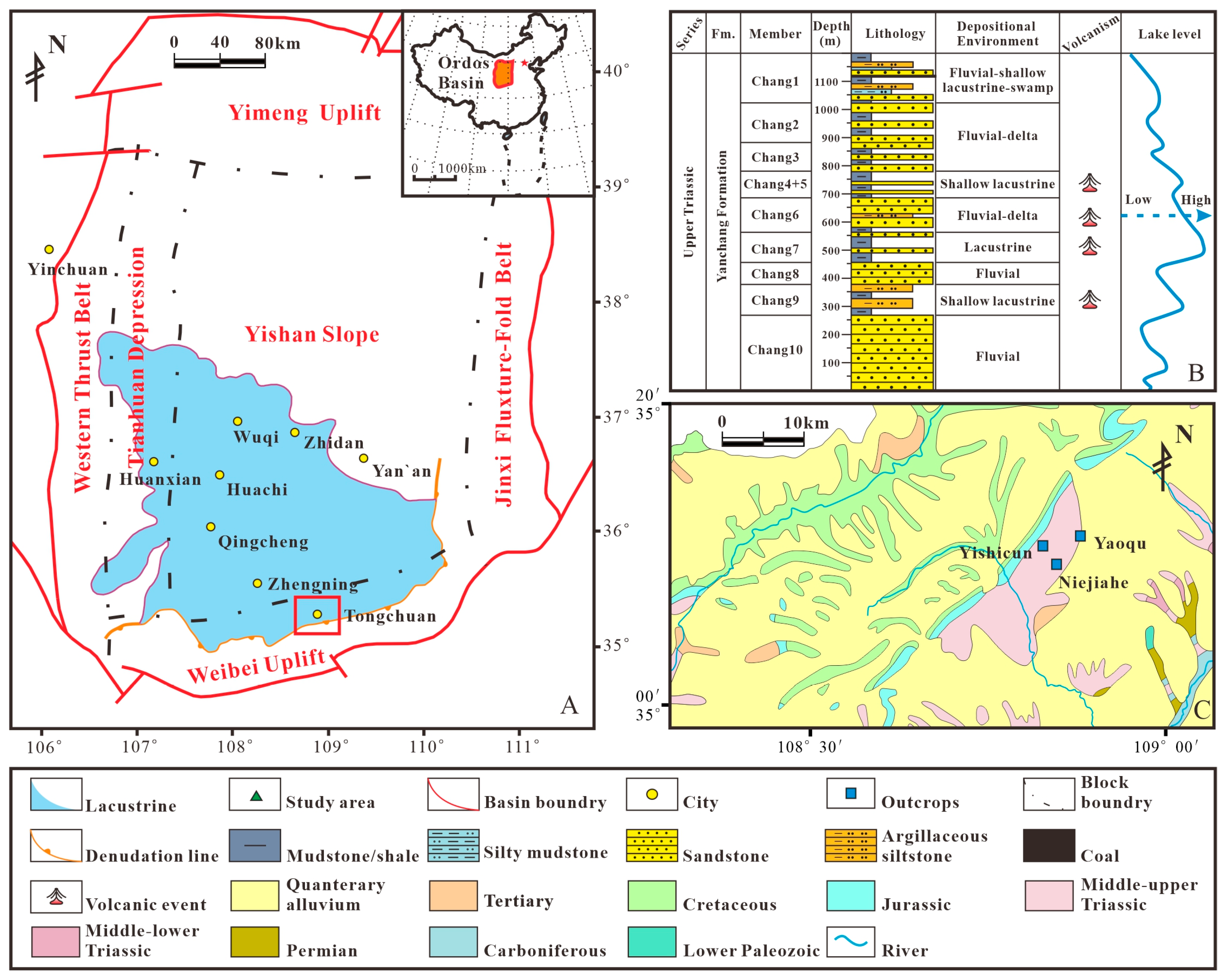

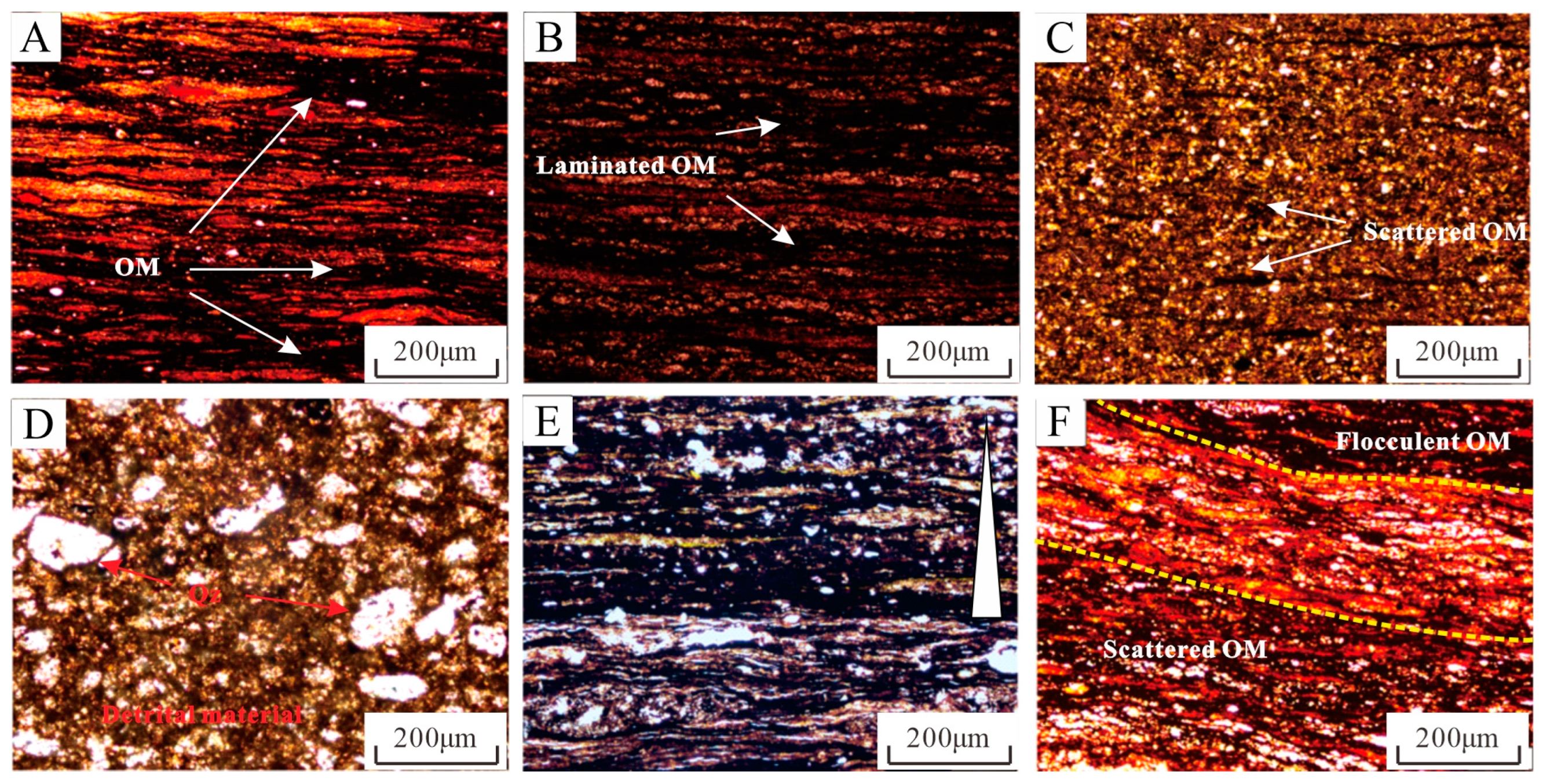
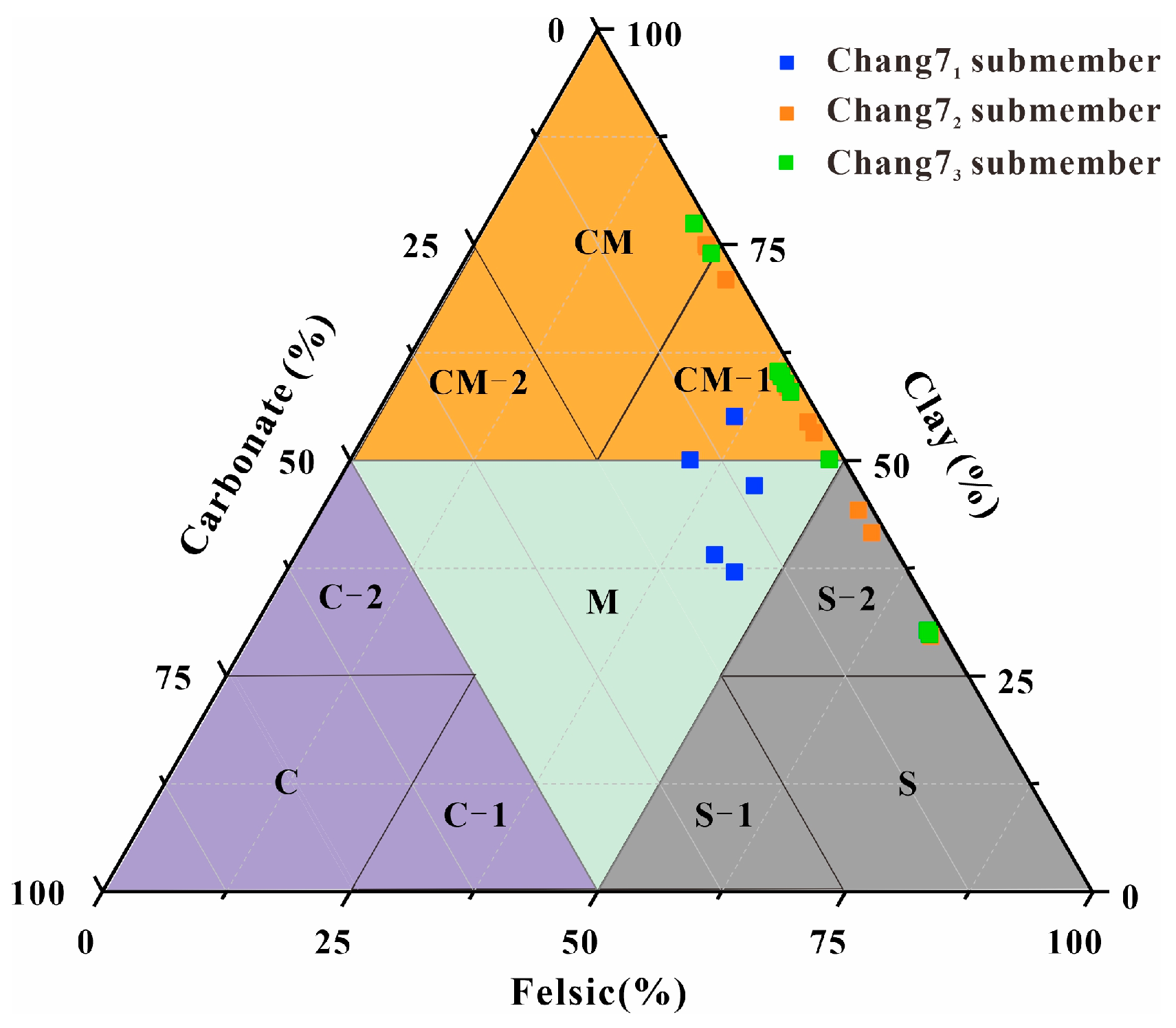
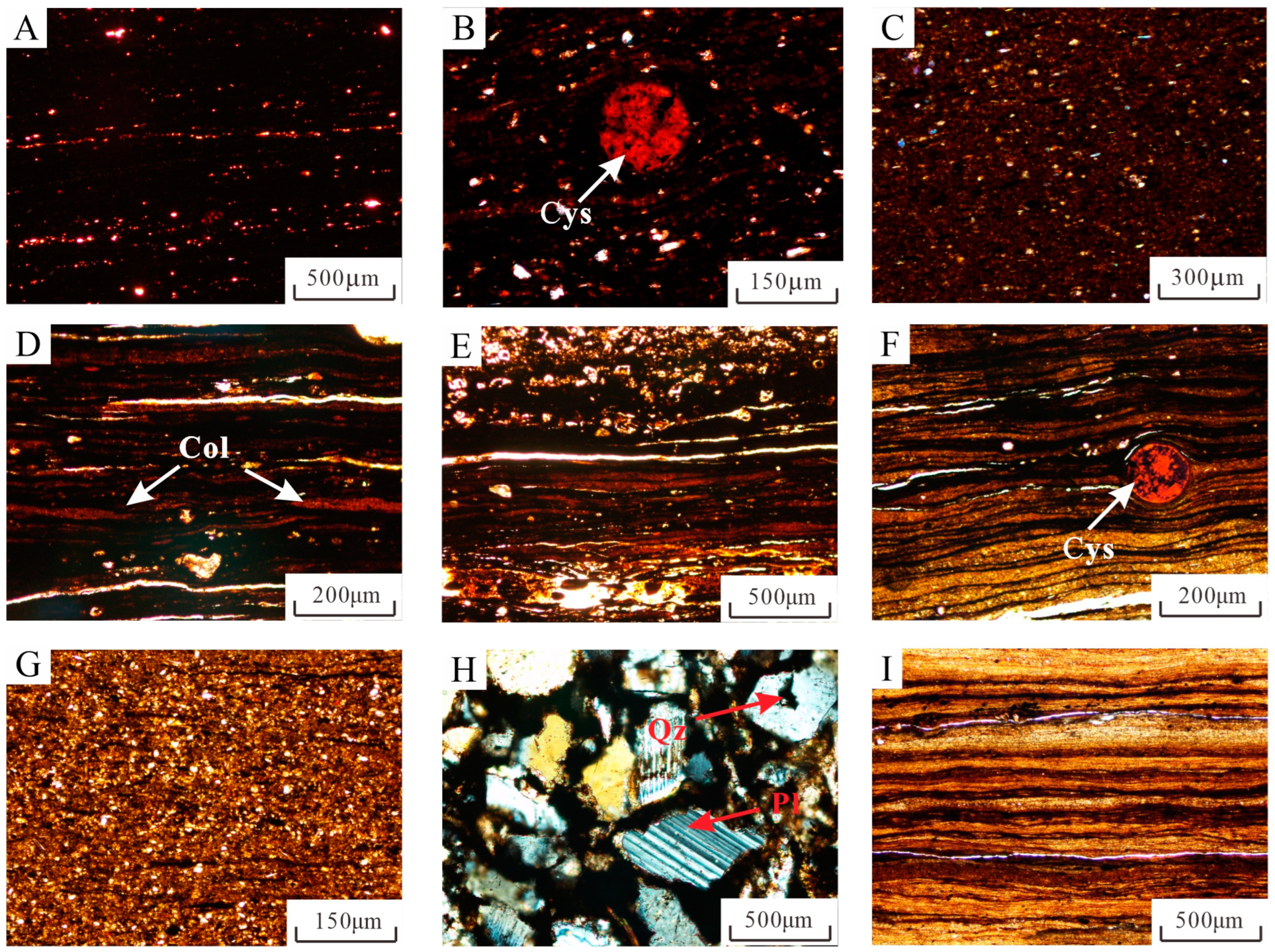
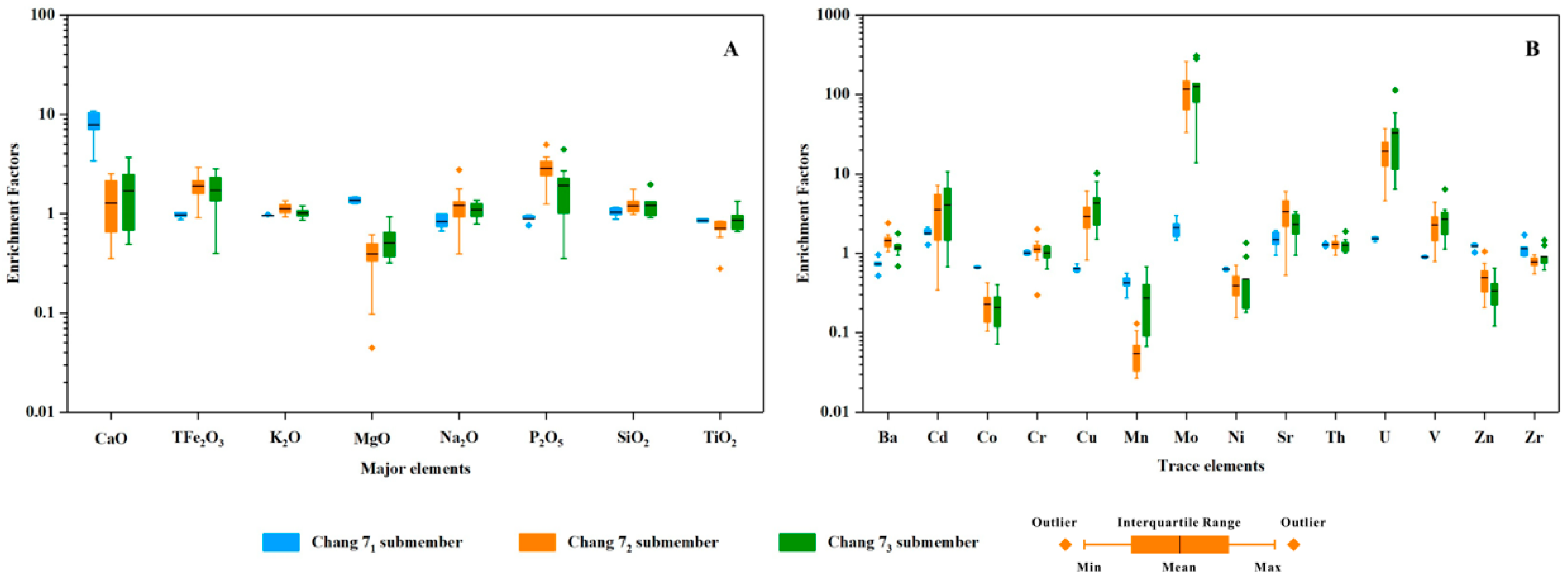
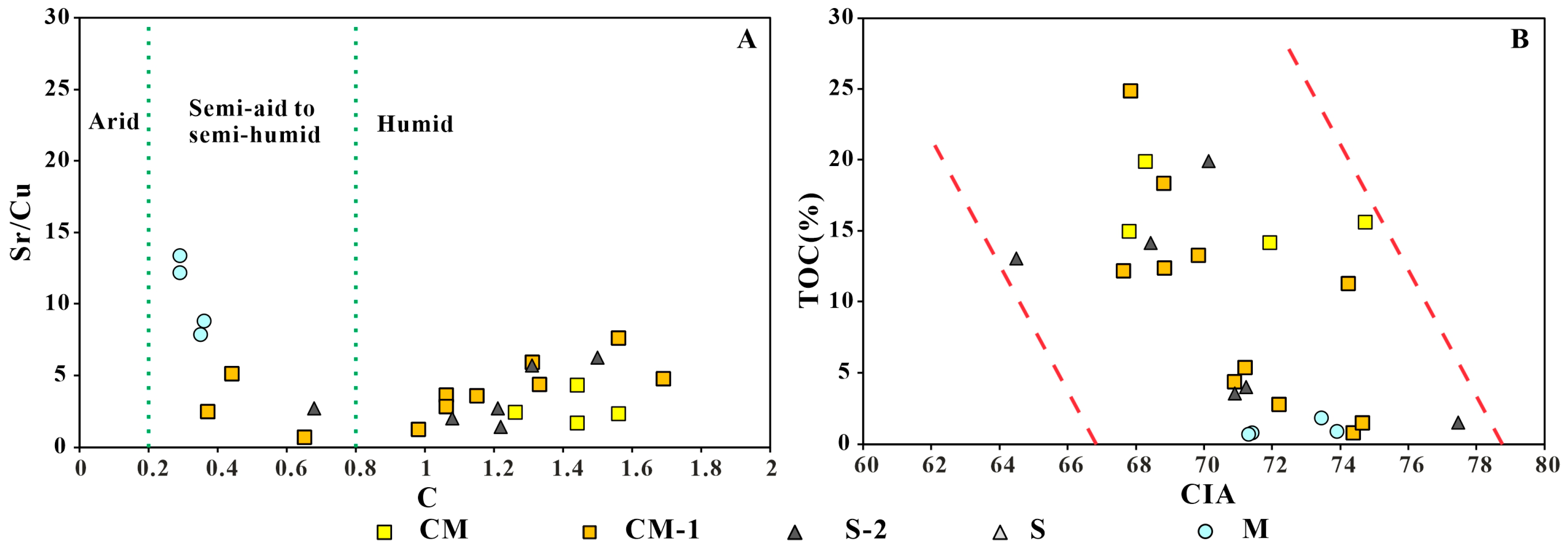



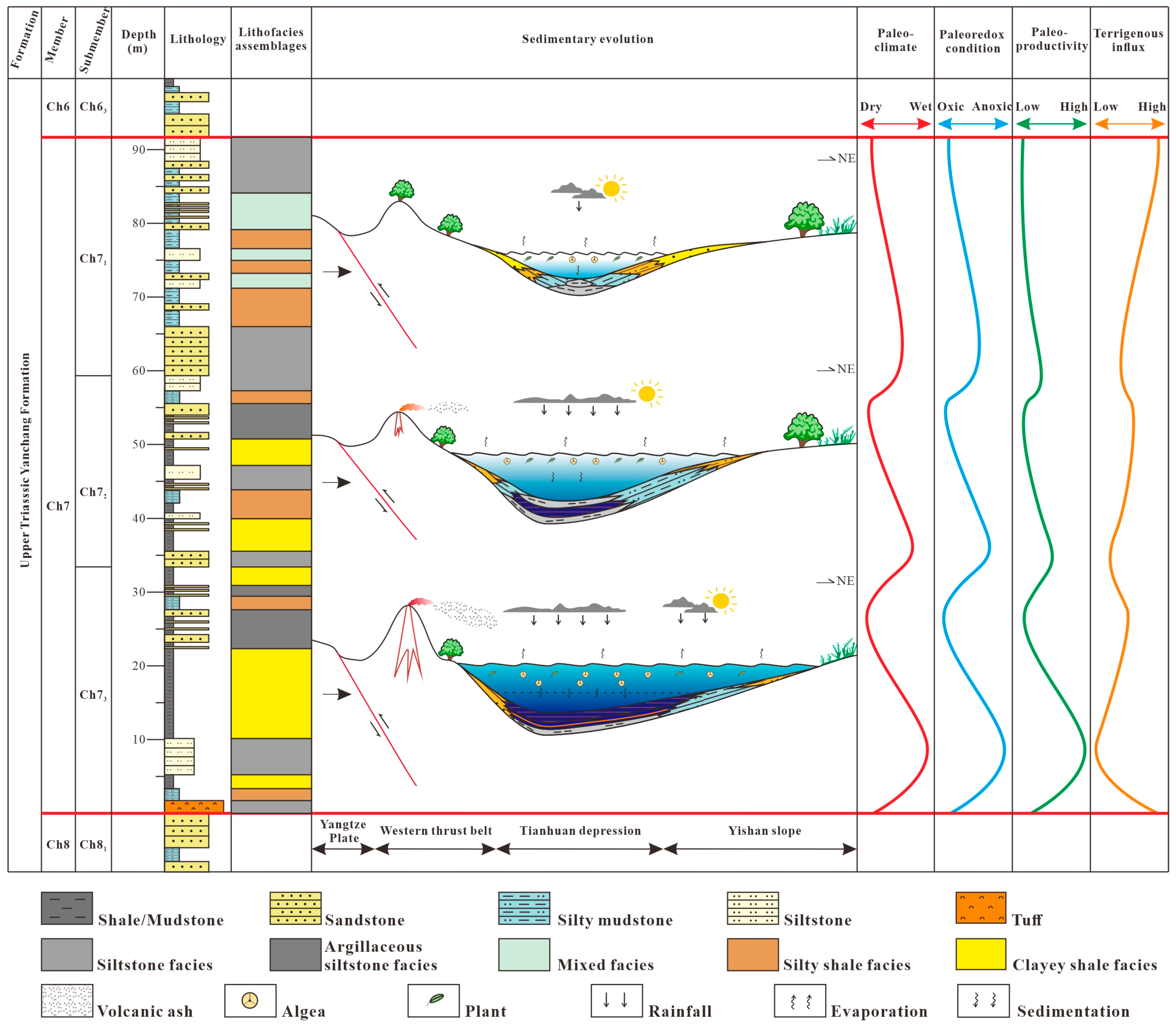
| Mb. | No. | SiO2 | TiO2 | Al2O3 | TFe2O3 | MgO | CaO | Na2O | K2O | P2O5 |
|---|---|---|---|---|---|---|---|---|---|---|
| Chang 71 | S. 1 | 52.12 | 0.65 | 15.62 | 4.96 | 2.37 | 7.66 | 0.73 | 3.00 | 0.14 |
| S. 2 | 51.16 | 0.65 | 15.73 | 5.48 | 2.45 | 8.30 | 0.70 | 3.01 | 0.14 | |
| S. 3 | 51.81 | 0.60 | 13.46 | 4.69 | 2.38 | 10.15 | 0.80 | 2.55 | 0.13 | |
| S. 4 | 51.73 | 0.61 | 13.74 | 4.73 | 2.40 | 9.99 | 0.82 | 2.62 | 0.13 | |
| S. 5 | 53.78 | 0.76 | 18.40 | 5.44 | 2.93 | 4.36 | 0.74 | 3.61 | 0.14 | |
| Chang 72 | S. 6 | 42.71 | 0.44 | 13.09 | 7.88 | 0.71 | 0.67 | 0.73 | 2.74 | 0.40 |
| S. 7 | 50.72 | 0.54 | 14.66 | 9.05 | 0.84 | 1.18 | 0.84 | 3.02 | 0.36 | |
| S. 8 | 44.15 | 0.48 | 11.48 | 9.72 | 0.71 | 1.72 | 0.96 | 2.16 | 0.57 | |
| S. 9 | 35.23 | 0.39 | 9.44 | 9.38 | 0.69 | 1.66 | 0.63 | 2.04 | 0.27 | |
| S. 10 | 62.39 | 0.45 | 10.69 | 7.42 | 0.57 | 0.71 | 0.80 | 2.20 | 0.28 | |
| S. 11 | 44.47 | 0.37 | 10.23 | 7.62 | 0.47 | 1.80 | 1.09 | 1.89 | 0.38 | |
| S. 12 | 50.84 | 0.52 | 14.61 | 9.72 | 0.56 | 0.72 | 0.82 | 3.95 | 0.39 | |
| S. 13 | 47.32 | 0.55 | 13.11 | 6.34 | 0.69 | 0.97 | 0.66 | 3.48 | 0.26 | |
| S. 14 | 59.74 | 0.49 | 16.93 | 6.69 | 0.09 | 0.42 | 0.40 | 4.19 | 0.43 | |
| S. 15 | 64.05 | 0.51 | 13.60 | 4.21 | 0.57 | 0.57 | 0.80 | 3.36 | 0.17 | |
| S. 16 | 39.56 | 0.46 | 11.65 | 8.29 | 0.82 | 1.75 | 0.86 | 2.50 | 0.28 | |
| Chang 73 | S. 17 | 37.20 | 0.43 | 12.36 | 8.59 | 0.67 | 1.32 | 0.88 | 2.12 | 0.55 |
| S. 18 | 32.89 | 0.42 | 8.79 | 6.96 | 0.39 | 1.52 | 0.59 | 1.98 | 0.20 | |
| S. 19 | 49.34 | 0.45 | 13.63 | 6.23 | 0.52 | 0.56 | 0.77 | 2.86 | 0.27 | |
| S. 20 | 39.18 | 0.41 | 9.52 | 2.92 | 0.42 | 1.43 | 0.78 | 1.80 | 0.19 | |
| S. 21 | 51.39 | 0.42 | 11.78 | 5.81 | 0.58 | 0.56 | 0.89 | 2.81 | 0.18 | |
| S. 22 | 44.15 | 0.45 | 6.75 | 5.30 | 0.63 | 1.74 | 0.42 | 1.38 | 0.13 | |
| S. 23 | 45.55 | 0.55 | 10.42 | 9.94 | 0.46 | 1.46 | 0.70 | 2.01 | 0.28 | |
| S. 24 | 44.90 | 0.50 | 10.82 | 7.91 | 1.20 | 2.06 | 0.84 | 2.06 | 0.11 | |
| S. 25 | 54.69 | 0.63 | 17.12 | 8.01 | 1.32 | 0.83 | 0.89 | 3.68 | 0.15 | |
| S. 26 | 62.16 | 0.68 | 19.79 | 2.68 | 1.05 | 0.68 | 0.93 | 3.81 | 0.07 |
| Mb. | No. | Ba | Cd | Co | Cr | Cu | Mn | Mo | Ni | Sr | Th | U | V | Zn | Zr |
|---|---|---|---|---|---|---|---|---|---|---|---|---|---|---|---|
| Chang 71 | S. 1 | 527.00 | 0.16 | 12.70 | 100.00 | 27.90 | 382.00 | 1.81 | 31.30 | 219.00 | 15.60 | 4.30 | 112.00 | 92.00 | 165.00 |
| S. 2 | 394.00 | 0.14 | 12.80 | 90.00 | 28.10 | 370.00 | 2.10 | 29.00 | 248.00 | 15.25 | 3.70 | 116.00 | 94.00 | 167.00 | |
| S. 3 | 374.00 | 0.15 | 11.80 | 90.00 | 21.70 | 403.00 | 2.34 | 26.40 | 290.00 | 14.45 | 3.70 | 96.00 | 85.00 | 268.00 | |
| S. 4 | 375.00 | 0.13 | 11.40 | 80.00 | 23.20 | 474.00 | 1.31 | 26.80 | 283.00 | 14.45 | 3.70 | 106.00 | 79.00 | 195.00 | |
| S. 5 | 334.00 | 0.12 | 15.80 | 110.00 | 36.20 | 298.00 | 1.50 | 32.20 | 185.50 | 18.45 | 4.60 | 140.00 | 86.00 | 195.00 | |
| Chang 72 | S. 6 | 633.00 | 0.11 | 1.70 | 90.00 | 109.50 | 21.00 | 108.50 | 11.00 | 474.00 | 14.45 | 46.70 | 263.00 | 18.00 | 110.00 |
| S. 7 | 673.00 | 0.34 | 4.80 | 90.00 | 106.50 | 92.00 | 70.50 | 15.30 | 468.00 | 13.50 | 42.30 | 244.00 | 43.00 | 113.00 | |
| S. 8 | 650.00 | 0.29 | 3.60 | 70.00 | 85.60 | 27.00 | 92.70 | 16.40 | 651.00 | 11.65 | 52.70 | 253.00 | 23.00 | 109.00 | |
| S. 9 | 553.00 | 0.28 | 2.40 | 110.00 | 89.40 | 19.00 | 134.50 | 17.00 | 425.00 | 10.75 | 43.70 | 330.00 | 15.00 | 95.00 | |
| S. 10 | 401.00 | 0.12 | 4.20 | 90.00 | 68.90 | 58.00 | 42.00 | 11.00 | 429.00 | 11.25 | 22.80 | 187.00 | 28.00 | 105.00 | |
| S. 11 | 530.00 | 0.37 | 3.10 | 50.00 | 115.50 | 22.00 | 73.20 | 21.40 | 658.00 | 8.66 | 34.60 | 247.00 | 23.00 | 110.00 | |
| S. 12 | 749.00 | 0.23 | 4.40 | 90.00 | 80.40 | 39.00 | 72.60 | 13.20 | 478.00 | 10.80 | 29.40 | 178.00 | 25.00 | 100.00 | |
| S. 13 | 509.00 | 0.44 | 4.70 | 90.00 | 139.50 | 22.00 | 100.00 | 20.60 | 176.00 | 13.35 | 48.10 | 290.00 | 28.00 | 130.00 | |
| S. 14 | 779.00 | 0.03 | 9.00 | 30.00 | 48.30 | 132.00 | 31.60 | 15.60 | 97.30 | 15.40 | 44.20 | 109.00 | 82.00 | 107.00 | |
| S. 15 | 501.00 | 0.09 | 2.10 | 90.00 | 75.50 | 33.00 | 44.90 | 8.10 | 204.00 | 13.20 | 28.50 | 150.00 | 13.00 | 112.00 | |
| S. 16 | 576.00 | 0.23 | 2.10 | 80.00 | 192.00 | 33.00 | 139.00 | 13.00 | 466.00 | 13.00 | 73.00 | 306.00 | 15.00 | 109.00 | |
| Chang 73 | S. 17 | 496.00 | 0.30 | 6.40 | 70.00 | 78.00 | 168.00 | 97.80 | 16.00 | 184.00 | 10.15 | 24.40 | 232.00 | 38.00 | 89.00 |
| S. 18 | 385.00 | 0.29 | 3.60 | 50.00 | 116.00 | 93.00 | 148.00 | 11.80 | 196.50 | 7.85 | 46.50 | 245.00 | 19.00 | 87.00 | |
| S. 19 | 547.00 | 0.13 | 2.30 | 70.00 | 130.50 | 116.00 | 69.20 | 7.30 | 465.00 | 14.55 | 48.80 | 283.00 | 16.00 | 116.00 | |
| S. 20 | 377.00 | 0.26 | 2.70 | 70.00 | 260.00 | 111.00 | 149.00 | 10.80 | 179.50 | 8.53 | 92.80 | 487.00 | 16.00 | 88.00 | |
| S. 21 | 519.00 | 0.10 | 1.70 | 60.00 | 91.00 | 62.00 | 51.70 | 10.10 | 332.00 | 11.80 | 70.60 | 181.00 | 16.00 | 117.00 | |
| S. 22 | 269.00 | 0.23 | 2.40 | 50.00 | 147.50 | 273.00 | 45.10 | 18.40 | 209.00 | 10.15 | 131.00 | 181.00 | 12.00 | 97.00 | |
| S. 23 | 666.00 | 0.08 | 1.30 | 40.00 | 61.80 | 257.00 | 70.50 | 12.30 | 385.00 | 8.95 | 46.90 | 150.00 | 6.00 | 177.00 | |
| S. 24 | 463.00 | 0.60 | 3.50 | 80.00 | 139.00 | 449.00 | 54.60 | 44.60 | 372.00 | 12.95 | 26.80 | 230.00 | 21.00 | 114.00 | |
| S. 25 | 579.00 | 0.07 | 3.00 | 110.00 | 129.00 | 93.00 | 36.00 | 10.40 | 365.00 | 15.15 | 25.20 | 227.00 | 18.00 | 155.00 | |
| S. 26 | 484.00 | 0.07 | 1.80 | 120.00 | 81.60 | 81.00 | 15.60 | 10.90 | 204.00 | 16.15 | 21.70 | 183.00 | 16.00 | 160.00 |
Disclaimer/Publisher’s Note: The statements, opinions and data contained in all publications are solely those of the individual author(s) and contributor(s) and not of MDPI and/or the editor(s). MDPI and/or the editor(s) disclaim responsibility for any injury to people or property resulting from any ideas, methods, instructions or products referred to in the content. |
© 2023 by the authors. Licensee MDPI, Basel, Switzerland. This article is an open access article distributed under the terms and conditions of the Creative Commons Attribution (CC BY) license (https://creativecommons.org/licenses/by/4.0/).
Share and Cite
Chen, Z.; Li, X.; Chen, H.; Duan, Z.; Qiu, Z.; Zhou, X.; Hou, Y. The Characteristics of Lithofacies and Depositional Model of Fine-Grained Sedimentary Rocks in the Ordos Basin, China. Energies 2023, 16, 2390. https://doi.org/10.3390/en16052390
Chen Z, Li X, Chen H, Duan Z, Qiu Z, Zhou X, Hou Y. The Characteristics of Lithofacies and Depositional Model of Fine-Grained Sedimentary Rocks in the Ordos Basin, China. Energies. 2023; 16(5):2390. https://doi.org/10.3390/en16052390
Chicago/Turabian StyleChen, Zhenhong, Xincheng Li, Hao Chen, Zhennan Duan, Zhen Qiu, Xiaoqian Zhou, and Yuguang Hou. 2023. "The Characteristics of Lithofacies and Depositional Model of Fine-Grained Sedimentary Rocks in the Ordos Basin, China" Energies 16, no. 5: 2390. https://doi.org/10.3390/en16052390
APA StyleChen, Z., Li, X., Chen, H., Duan, Z., Qiu, Z., Zhou, X., & Hou, Y. (2023). The Characteristics of Lithofacies and Depositional Model of Fine-Grained Sedimentary Rocks in the Ordos Basin, China. Energies, 16(5), 2390. https://doi.org/10.3390/en16052390










